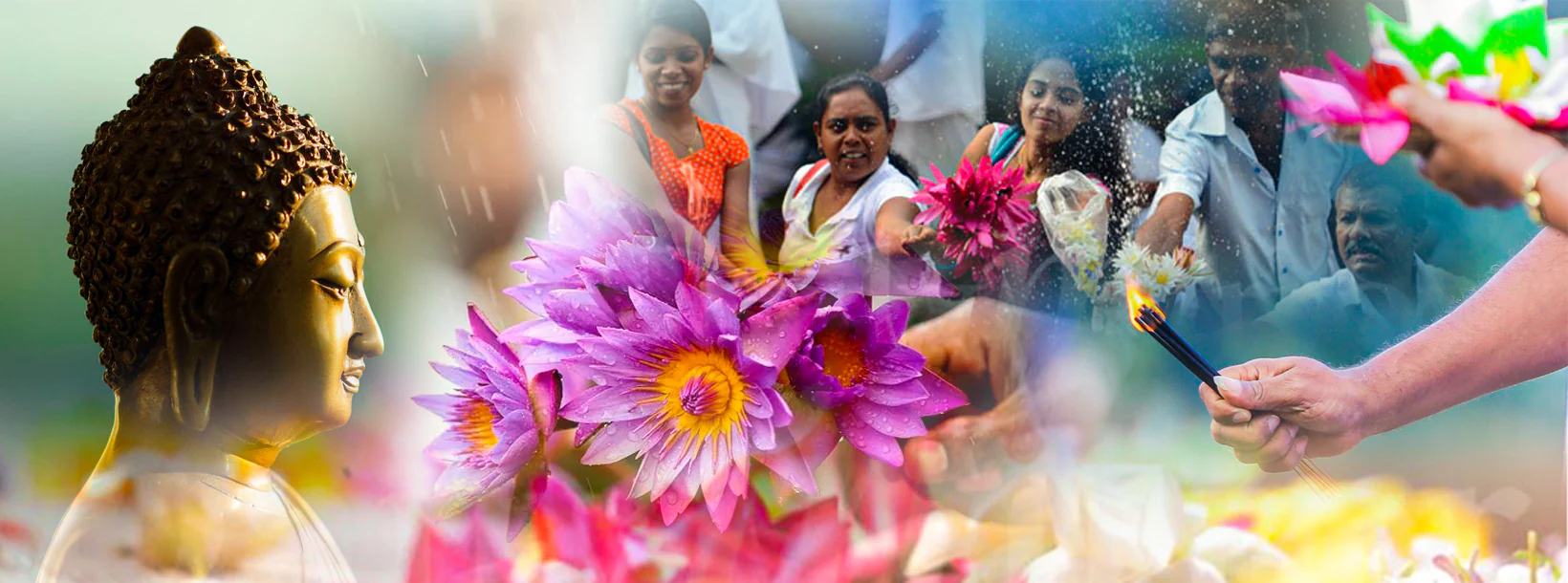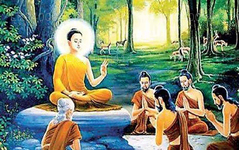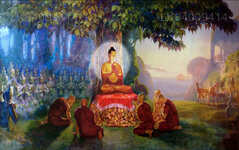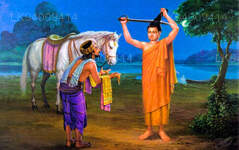
Poya Days
Sri Lankan Poya days are monthly Buddhist holidays that commemorate events in the life of Lord Buddha. There are 12 Poya days in a year, with each one dedicated to a specific event. These days are significant in Sri Lankan culture and are observed with religious activities and ceremonies.
Esala Poya (ඇසල පෝය)
Esala Full Moon Poya is very important in the Buddhist calendar. It was on the Esala Full Moon Poya Day the Buddha arrived at the deer park of Isipathana to preach Dhamma to Ven. Kondangna, Vappa, Bhaddiya, Mahanama and Assaji, the five ascetics. The Buddha delivered His first discourse Dhammacakkappavattana Sutta to them. At the end, the eldest Kondangna Thera attained the first stage of sainthood. According to Buddhist history, many significant events had taken place on the Esala Full Moon Poya Day. Among them, the conception of Prince Siddartha in Queen Mahamaya’s womb occurred on the Esala Full Moon Poya Day. Buddhist literature reveals that a thousand years ago Queen Mahamaya, in one of her previous lives had the same unusual dream on an Esala Full Moon Poya Day.
It was on this day that King Suddhodana, Prince Siddartha’s father was conveyed the happy news by Queen Mahamaya, the mother of Prince Siddartha. The Queen had woken up early in the morning and informed the King about this. The King had a deep thought of the dream and knew that a great person was conceived in Queen Mahamaya’s womb. According to the dream, four guardian deities of the world carried the Queen in a beautiful couch to the snow clad foothills of the Himalayan Mountain Range, where a white baby elephant that had a white lotus flower in its trunk walked thrice round the couch of the sleeping Queen Mahamaya. Thereafter, the baby elephant entered into her womb from the right side of the abdomen. The dream came to an end and the Queen was suddenly awakened. The next morning Queen Mahamaya revealed everything about the previous night’s dream to King Suddhodana. The King realised that the dream indicated a good news, the conception of a very great person to the world. It was the Esala Full Moon Poya Day, Queen Mahamaya was conceived Bodisattva. The King and the Queen did not have a child for 20 years. Therefore, the happy news was a joyful event not only for the King and the Queen, but the maids and other workers employed in the King’s palace. The Prince was born on the Vesak Full Moon Poya Day.
History reveals that the month of Vesak was introduced to the Buddhist calendar during the Vishaka Era. Prince Siddartha was also born in a month belonged to the Vishaka Era. It was the fifth month according to the Roman calendar. The three significant incidents in the life of the Buddha, the Birth, enlightenment and the passing away took place on the same Full Moon Poya Day during the Vishaka era. Therefore, Buddhists call it as the Vesak Full Moon Poya Day. Prince Siddartha’s mother, Queen Mahamaya passed away after seven days of his birth. The Prince was thereafter looked after by his step-mother Queen Maha Prajapathi Gothami, the sister of Queen Mahamaya. After the death, Queen Mahamaya was born in the Thavthisa heaven. The Prince lived a luxurious life. He realised that the life was impermanent and full of suffering. Therefore, he was always determined to find a path or a way to solve the problems of universal sufferings. At the age of 29, the prince decided to leave the palace, leaving all comforts to find the way out of universal suffering. The great Renunciation also took place on an Esala Full Moon Poya Day, 2,600 years ago.
It was on the Esala Poya Day, seven weeks after the attainment of Buddhahood, the Buddha delivered His first discourse, the Dhammachakkapavattna Sutta (the wheel of truth) to the five Ascetics, Kondanna, Vappa, Bhaddiya, Mahanama and Assaji at Isipathanaya in Benares (Baranasi). The sermon consisted of the central teachings of the Buddha – the Four Noble Truths and the Noble Eightfold Path. At the end of the Sutta the eldest Kondangna Thera attained sotapatti, the first stage of sainthood. The Buddha says, “What, O Bhikkus, is that middle path the Thathagatha has discovered which promotes sight, knowledge, peace, higher wisdom, Enlightenment and Nibbana? It is this Noble Eightfold Path”.Hearing the discourse, the other four ascetics later attained the status of Arahat. The five ascetics were the first disciples of the Buddha. He spent three months with these pancha vagga bhikkhus in Isipatanaramaya.
The book The Discovery of India, written by former Indian Prime Minister Sri Jawaharlal Nehru mentions how he sees the Buddha preaching his first sermon” at Saranath near Baranasi. He said, “Some of his recorded words would come like a distant echo through two thousand five hundred years ago.” The observance of Vas by the Maha Sangha during the rainy season was introduced by the Buddha when he was with the five bhikkhus. The commencement of the rainy season began from the month of Esala. Vas signifies the cessation from going about begging alms (Pindapatha) during the rainy season for the bhikkhus residing in a definite place, either in a sanctuary of their respective vihares or in a particular abode. Buddhist laity provided the bhikkhus with food, robes and other necessities during the rainy season. In return for this gesture, the bhikkus were told by the Buddha to engage in the practice of ‘Vidharshana Bhavana’ meditation and make the laity partake of the merit.
Furthermore, Esala also signifies a number of important events in the life of the Buddha. It was on Esala Full Moon Poya Day, the Buddha visited Thusitha Heaven by using his miraculous power to preach the Abhidhamma to his mother the Matru Divyaraja and other gods. The convocation of the first Buddhist Council (First Dharma Sangayana) was held on the Esala Poya Day under the patronage of King Ajasaththa, three months after the Parinibbana of the Buddha at the Satipattana cave on the vehera rock near Rajagaha. It was headed by the Ven Maha Kassapa with the participation of 500 Arahats. It was on the same Esala Full Moon Poya Day, that Prince Rahula, the only child of Prince Sdiddartha and Princess Yasodara was born. The day Prince Siddartha saw the whole world including His wife and child suffering not knowing the way out of it. The Prince left home in prime of his youth. Buddhists still believe that his Great Renunciation was the boldest step that a man has ever taken.
An additional factor that enhances the value of this poya to Sri Lanka is the first local ordination of a Sri Lankan, when Prince Arittha, the nephew of the king, entered the Order at Anuradhapura, under Arahant Mahinda, following the introduction of Buddhism. On this day there also took place the laying of the foundation for the celebrated dagoba, the Mahastupa or the Ruwanvelisaya and also its enshrinement of relics by King Dutugemunu. It is owing to the combination of all these events that the Sinhala Buddhists fittingly observe this day ceremonially by holding Esala festivals throughout the island, giving pride of place to the internationally famous Kandy Esala Perahera.
Esala poya assumes prominence for yet another ritual of the Sri Lankan Buddhists. This is the annual rains retreat of the monks, 'Vas', which commences on the day following the Esala full moon. On the next poya day, Nikini (August), those monks who failed to commence the normal Vas on the day following Esala Poya, are allowed to enter the 'late Vas.






















